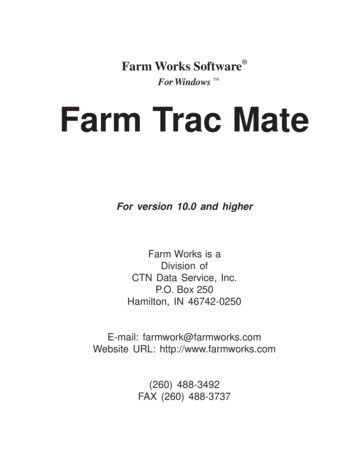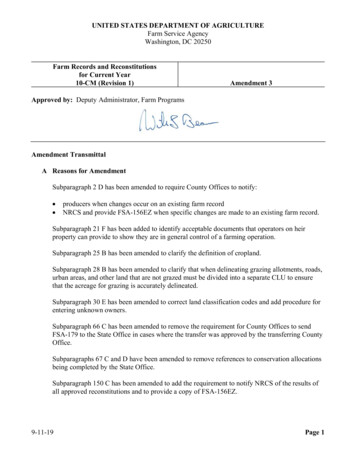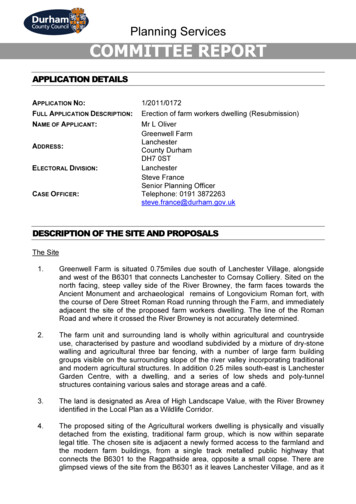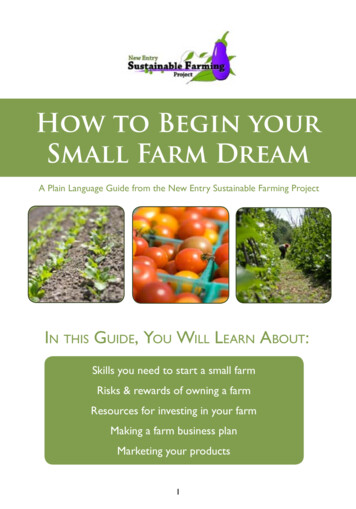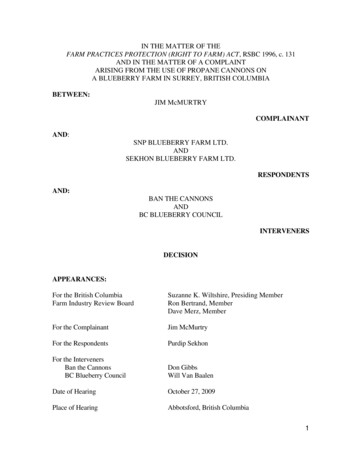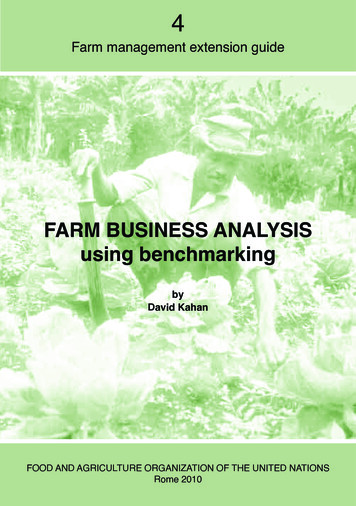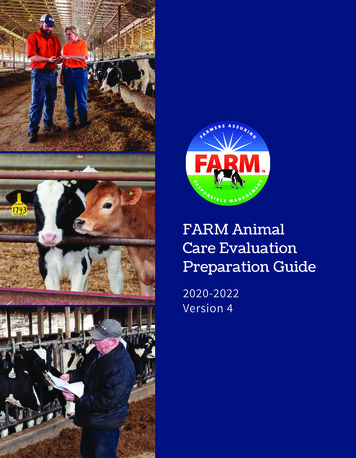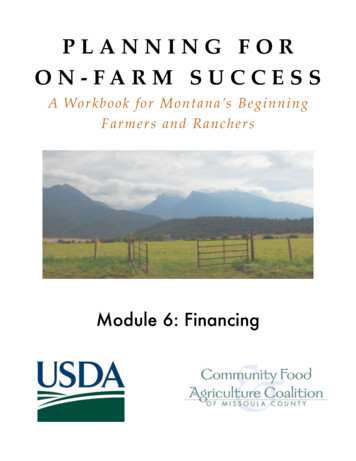
Transcription
PLANNING FORON-FARM SUCCESSA Wor kbook for Mon t an a’s Be g in n in gFarmers and RanchersModule 6: Financing
This workbook was developed by the Community Food & Agriculture Coalition in cooperation with MontanaState University Extension, the National Center for Appropriate Technology, the Montana CommunityDevelopment Corporation, and the Lake County Community Development Corporation, with funding from theUnited States Department of Agriculture. This publication was developed as part of USDA RMA grant no. 13IE-53102-17, Crop Insurance and Risk Management Training for Beginning Specialty Crop Producer in WesternMontana and USDA NIFA grant no. 2015-70017-22851, Building On-Farm Success: Resources and Training forMontana’s Beginning Farmers and Ranchers.This workbook draws heavily from the following publication, which can be viewed online at misa.umn.edu. Inaddition to a large amount of the body of the document, all worksheets, unless otherwise noted, come from thefollowing publication:Minnesota Institute for Sustainable Agriculture. Building a Sustainable Business: a guide to developing a business planfor farms and rural businesses. College Park, MD: Sustainable Agriculture Research and Education (SARE), 2003.!!!Photo: Dorothy PatentPhoto: Cathrine WaltersPhoto: Pedro MarquesEditorAnnie Heuscher, Community Food & Agriculture CoalitionContributors/ReviewersSeth Swanson, MSU ExtensionTammy Hinman, National Center for Appropriate TechnologyAmita Patel Greer, Montana Community Development CorporationJan Tusick, Lake County Community Development CorporationBonnie Buckingham, Community Food & Agriculture CoalitionTara Beley, Risk Management AgencyBrianna Ewert, FarmerDavid Wise, Community Food & Agriculture CoalitionAutumn Lee, Community Food & Agriculture CoalitionCedar Brant, Nourish the FlatheadAdditional PartnersMontana Farmers’ UnionAlternative Energy Resources OrganizationWestern Montana Growers’ CooperativeMontana Department of AgricultureFarm Service Agency
Module 6: FinancingThe financing strategy you develop will depend on your choice of business organization and your values as theyrelate to risk, control, costs and maturity. Historically, farm businesses have financed themselves internallythrough family equity—relying on debt only when internal equity was not adequate to finance growth of thebusiness. Today, however, external financing through debt, leasing, and outside equity is common.Where to StartObviously, the most inexpensive source of money for your new farm is your own cash - no interest on loans, nohome equity, no family loans, and no credit cards. Relying on loans substantially (or entirely) puts your farmdreams at too great a risk. It is worth the patience to build up your own farm start-up account. Personal resourcesoftentimes wind up being one of the few financial resources available to farmers during start-up.Many farmers in Montana are seeing competition in the commodity market making business more and morechallenging and are looking for ways to diversify their production, add value to their crops, or grow somethingentirely new to a local market. These are typically seen as great ways to make a business more secure andsustainable. However, with farm financing, it oftentimes also makes the business appear more risky becauselenders may not be familiar with the types of production, products, or markets the farmer is proposing.Deciding how to finance your farm has a lot to do with your business stage and your finances. If you can usepersonal resources, grants, donations, cost-share programs, leasing, and maybe some family and friends to getyourself to the point where you’re selling product and bringing in revenue, a wide array of additional financingopportunities will present themselves to you. You’ll have proven that you can produce your product and you’llhave proven that there’s a market for it that’s willing to pay your price. Those pieces of information are critical toa lender and will greatly help your case.If you’re planning a business that will require significant start-up costs before you start bringing in revenue, theplaying field will get a little bit tougher. In that case, potential lenders and investors are going to be looking atyour marketing plans and financials with higher scrutiny. There’s a good chance you’ll be dealing with lenders orinvestors who aren’t familiar with your field or your product, so making your business plan as compelling andeducational as possible will be crucial. They will also want to know about your team and what it brings to yourbusiness that will make it thrive.Most importantly, lenders and investors whether friends or bankers or wealthy neighbors, want to know thattheir loan to you or investment in you will either make them money or, at least, be paid back. Therefore, it’s ofutmost importance that you are comfortable with and confident in your numbers. Consider creating a budgetnarrative that explains why you’ve estimated your numbers as you have. Anything you can do to help a financialpartner to have confidence in your business will help your chances of walking out the door with money.If you anticipate the need for financing to pay for start-up, annual operating, or long-term capital expenses, youhave several options to consider. Some common internal and external financing alternatives are described in thetables on the following pages. Much of the content in these two tables is derived from resources created by SlowMoney Northern California1 and SunTrust Bank.2 Note: this chart and set of descriptions describe financingspecifically for your business. Real estate financing can be a bit different and is covered later in this section and inModule 8.As you’ll notice from the chart below, business stage plays a key role in what types of financing are available toyou. When you have an idea for a business and you’re doing market research, product testing, etc., it will beextremely hard to find outside financing. When you’re pre-revenue, i.e. spending money to raise cattle but not yet12Slow Money Northern California, Stages and Funding Options. 2012SunTrust Bank, 12 Financing Options. nd.Module 6: FinancingPage 1!
selling them, you may find a few new avenues that will present themselves because you will have donesignificant planning and research to get there. By the time you’re entering the market and starting to make sales,many more options become available, as you put facts behind the estimates in your business plan.The stage between entering the market and approaching profitability, meaning that you’re making profits overalleach year, may take several years. Most businesses try to have start-up cash on hand for the first three years ofbusiness because it can oftentimes take that long to start bringing in profits. Once you are approachingprofitability or are profitable, certain financing types start to become less ideal. If you’re still using your personalresources to finance your business as you’re approaching profitability, that may be a bad sign. If however, thebusiness is making enough annual profits to re-invest those into the business, that’s a great sign! As you becomeprofitable, you may find it more challenging to acquire donations and grants as some individuals andorganizations will feel that you have the ability to stand on your own two feet. Similarly, some equity investorswill become less interested because they are typically looking for businesses that they can buy into for low pricesand sell high. Until you are ready for dramatic expansion, those financiers may not be viable.One thing to remember about investors: with the exception of Slow Money investors, investors are typicallylooking for high-growth businesses that will offer them quick and substantial returns on their investments. If youare starting a farm or ranch because you want that business to be your lifestyle, but you don’t have plans ofexpanding the business and selling it to a major corporation or competitor, equity investors will probably not be agood fit for you.Types of Financing and Appropriate Business StagesModule 6: FinancingPage 2!
Further Descriptions of Business Financing TypesWhat is it?FreeMoneyGrantsAwards from private andgovernmental organiza4onsDo not have to be repaidDona:onsGi@s from private individualsor organiza4onsDo not have to be repaidCost ShareTypically associated withNRCS programs; NRCS willpay a por4on of the cost ofthe improvement and youwill pay the restNRCS does not requirerepayment as long as youmake and maintain theimprovement as promisedCreditCardPersonally secured businesscredit cardsAvailable to owners withcredits and assets; May bean op4on if you are not ableto get a eivablesFinancingVendorCreditModule 6: FinancingSmaller loans with moreflexible terms, underwriOenby SBA or delivered bycommunity-based banks; Canalso be peer-to-peer lending,which o@en4mes has a 0%interest rateSelling royal4es on use of thename, image, or logo of yourproduct in other licensing (forexample, if KeOlehouseBrewing copyrighted the ColdSmoke name and a bakerywanted to make a "ColdSmoke" cupcake, they mightneed to pay royal4es toKeOlehouse)DrawbacksLimited to specialized fields andopera4ons. May come withterms or obliga4ons that mustbe met.Number of people willing todonate with no return may belimited; Strong appeal requiredMust follow specific NRCSspecifica4ons; NRCS funds onlybecome available a@er theimprovement has been madeand approvedExpensive with high interestrates and o@en4mes, variableterms; Not a good op4on forlong-term financingStart-up op4on; Coaching/technical assistance may beavailable; Connects thecommunity with yourprojectRela4vely small loans; nonbankloans (may not be an effec4veway to improve your creditscore)Provides cash without highexpenses (a@er copyrigh4ngor trademarking iscompleted)Must copyright or trademarkyour brand or product name,image, or logo, which can be anexpensive and 4me-consumingprocessBased on "accountsreceivable"; Using an exis4ngaccount or contract to securefinancingProvides cash and reducescollec4ons riskRela4vely risky; Based onexpecta4on that account/contract will be fulfilled; Limitedby volume/customercreditworthinessObtaining financing from avendor you typically sell to inexchange for future salesProvides a sort of "cashadvance" to cover lowincome periods; Can be aninexpensive credit op4onand good source of workingcapitalBecause payment is in advance,cash flow may be off when youdeliver goods; Limited bybusiness scale and suppliercreditPage 3!
LoansDebtLine ofCreditPersonalResourcesFamily &FriendsDebt odule 6: FinancingWhat is it?AdvantagesDrawbacksLoans from banks onstandard terms; Can alsoinclude loans fromgovernment agencies such asthe Farm Service Agency orpublic/private en44es likeNorthwest Farm Credit orCommunity DevelopmentCorpora4onsCan offer larger loanamounts and favorableterms; Loans fromgovernment or public/private en44es can havehighly reduced rates; Loansfrom government or public/private en44es may bewilling to take on businessplans with higher risks;Come in a variety of formsand termsChallenging for risky start-upopera4ons; Can be expensivewith high interest rates; Requiresclear documenta4on andbusiness plans; Requiresmo4vated and experiencedlenderAvailable to owners withcredit and assets; May be anop4on if you are not able toget a loan.Can be very expensive, with highinterest rates; Not a good op4onfor long-term financingAvailable to owners withsavings and cash flowLimited by personal assets andsavings; Poten4al risk tore4rement/savingsMay be an op4on if you arenot able to get a loan; Offerthe possibility of favorabletermsRisk to personal rela4onships;Control and management canbecome issuesUsing online tools such asWeFunder, CircleUp orCrowdfunder to adver4seand accept debt or equityinvestmentsAllows you to publicly offerand accept investmentsfrom non-accreditedinvestors; Simplifies filingrequirements; Creates widerpool of poten4al investorsthan just local investorsMay result in large numbers ofinvestors, which could causemanagement issues or futureproblems when you want to takeon addi4onal financingA loan that is converted intoequity when your businessreaches a certain level ofsuccessLess expensive and 4meconsuming than filing tocreate publicly-traded stocksUnlike straight equity, requirespayment un4l the debt isconverted; May have variabletermsSale of part of the companyto a private individual orgroup of individuals; Mayinvest as debt, conver4bledebt or equity; Typicallyinvest 5k - 100kAvailable to lower-growth orslow-growth companies;May provide governanceand advice; May haveflexible terms and be opento receiving product as loanpaymentsInvestors will s4ll need an "exitstrategy" even though you mayhave no plans to sell thebusiness; Not a loan; Give upfuture profits and possiblycontrolBetween a business loan anda credit card; Typically issueda specific amount of creditand you can use andwithdraw up to that amountof credit over a set period of4meFinancing the business frompersonal savings orinvestments; Can be used asdebt that the business willrepay or an investment in thebusinessLoans or investments fromindividual's friends andfamily; If the person expectsa financial return, securi4eslaw will likely be involvedPage 4!
What is it?EquityAdvantagesDrawbacksAngelSale of part of the companyto a private individual orgroup of individuals; Mayinvest as conver4ble debt orequity; Typically invest 50k 500kProvides capital for highgrowth companies; Mayprovide governance andadviceNot typically an op4on for startup or "lifestyle" businesses; Nota loan; Give up future profits andcontrolVentureSimilar to Angel Investors,but typically inves4ng 500kto 1MProvides capital for highgrowth companies; Mayprovide governance andadviceNot an op4on for start-up or"lifestyle" businesses; Not a loan;Give up future profits andcontrolPrivateSimilar to Angel or VentureCapital investors, but PrivateEquity investors are typicallyinterested in "turnaround"businesses with poten4al butpoorer numbersProvides capital for highgrowth companies; Mayprovide governance andadviceNot typically an op4on for startup or "lifestyle" businesses; Nota loan; Give up future profits andsignficant controlLeasingReduces payments for capitalequipment/vehicles byleasing rather thanpurchasingLower payments andimproved cash flowPre-Sales/CrowdfundingCrowdfunding is raising smallamounts of money from alarge number of people asdona4ons or advancedproduct sales; Examplesinclude Kickstarter andIndiegogoMay be an op4on if you arenot able to get a loan; Ifreceived as dona4ons, donot have to be repaidOtherHigher cost typically due tohigher interest; May come closeto paying off, miss somepayments, and lose allinvestmentRequire significant 4me and costinvestment for marke4ng to besuccessful; If received as presales, may impact future cashflow and can provide financingbeyond a business's capacity tomeet demandThe types of financing listed above are specifically related to business financing. However, if you want to start afarm or ranch, you will also need to consider real estate financing. Land and building investments typicallyaccount for the largest farm expense and have the potential to make or break your business. Luckily, real estatefinancing is typically a bit easier because your ability to pay is based on your own income and savings rather thanthe perceived performance of your future business. If you have a couple of years before you are planning onfarming full-time, having an existing off-farm job can be a great way to demonstrate creditworthiness to a lender.There is more on land access and different types of ownership arrangements (lease, purchase, crop-share,partnerships, etc.) in Module 8. For the purposes of this discussion, be aware that many of the same lenders thatwould finance your business – banks, Farm Service Agency, and Northwest Farm Credit – may offer real estateloans as well. They have widely varying rates and terms so it’s worthwhile talking to several before you allowthem to pull a credit report for you (if each one pulls your credit, it will likely have a negative impact on yourcredit score).Specific Funding OpportunitiesWhile we’ve talked broadly about the types of financing available, let’s dive into specific resources available inMontana.Free MoneyAs you might imagine, free money is hard to come by. Just like with any small business or new enterprise, youcan solicit donations for your work from friends and family. Now that crowdfunding has become a majorModule 6: FinancingPage 5!
phenomenon, there are a number of online resources that can help you cast a wider net with donation-seeking.These are covered below under “Other.”Grants USDA Rural Development offers two grant programs: Value Added Producer Grants which provideassistance to farmers who are developing new products, expanding markets, etc. with a value-addedproduct. The Rural Energy for America Program provides grant assistance for purchasing and constructingrenewable energy systems and can be used on-farm. Find your local office by visiting http://www.rurdev.usda.gov/MT offices.html. The Western Sustainability Agriculture Research & Education program is a government-funded grantprogram that provides funding for farmers to conduct research and education projects. These can includeprojects such as applying new sustainable practices on your farm and sharing the results with yourcommunity or conducting new research on your farm. For more information, visit http://www.westernsare.org/. The Montana Department of Agriculture’s Growth Through Agriculture (GTA) program offers grants andloans for new and innovative agriculture marketing ideas or agribusiness developments. For more info, visithttp://agr.mt.gov/agr/Producer/GrantsLoans/. The Red Ants Pants foundation. Red Ants Pants is an apparel company based in White Sulphur Springs thathosts a large music festival each year. They reinvest the profits into the community by offering communitygrants, sometimes given to businesses, for projects that enhance self-reliance in rural communities. For moreinfo, visit http://www.redantspantsfoundation.org/grants/. Your farm policy organization may offer grant opportunities, as Montana Farmers Union and Montana FarmBureau Federation do from time to time. For more information, visit their websites at http://montanafarmersunion.com/ and http://mfbf.org/.The primary cost-share program is offered bythe Natural Resources Conservation Servicethrough their Environmental QualityIncentives Program (EQIP). EQIP offers moneythat does not have to be repaid for on-farmconservation projects. There are a wide rangeof projects that fit their qualifications,including high tunnels, fencing, tree, windrows, irrigation, and many more. Contact yourlocal NRCS office for more info.If you’re looking to purchase electric fencingin regions of the state that have wildlifepredation issues, consider reaching out toDefenders of Wildlife. They have a programthat will match investments in electric fencingup to 500 ( 1,000 total). For moreinformation, contact them at (406) 728-8800.Debt“Debt” means money that you have to payback, typically with interest. You may havenoticed that on a number of the types of debtoutlined in the table above there were notesthat “terms” may be more or less flexible. Thisrefers to the interest rate, payment schedule,required collateral, and other bargaining chipsModule 6: FinancingStories from the FieldsTalking about financing, Connie Surber of the Golden Yoke Dairy in St.Igna4us emphasizes the importance of telling your story, being opento mul4ple op4ons, and finding the right fit. “We don’t hold back ontelling our story; we’ll tell it to anyone who wants to listen. We don’tnarrow financing op4ons down to one single place but explore arange of op4ons and try to find someone who wants to work withus.”When Connie was figuring out how to afford tui4on at Penn State’sIce Cream Short Course, she asked about scholarships but found thatnone were available; undeterred, she applied for and received grantsfrom Red Ants Pants Founda4on and the Montana Farmers Union,which together allowed her to aOend the course. Most recently, sheand Laura went through the state to acquire a Grow Through Ag grantthat allowed them to purchase a pasteurizer.For loans, Connie and Laura considered several op4ons, including theFarm Service Agency, Credit Unions, and the Montana CommunityDevelopment Corpora4on (MCDC). They decided to work with MCDCbecause, as Connie puts it, “What you get there is not just a loan withflexibility on interest rates and payment schedule, but also incrediblesupport. They’re just awesome.” Through word of mouth, Connie andLaura also obtained the support of two private investors, who haveset aside funds for Golden Yoke that they can access at whateverfuture date they need to. A por4on of the interest from the loans willgo into a Slow Money fund for new farmers in the future.Page 6!
that are on the table in the lending process. All of the forms of debt outlined above are available through a widearray of sources depending on your capacity. Banks may be the first things that come to mind, but here are a fewmore: The primary ag lender is the USDA Farm Service Agency (FSA). FSA offers an incredible range of loans andfunding opportunities and your best bet is to schedule a time to meet with someone in your local FSA officeto find out about programs that may apply to you. Their most popular are real estate and operating loans, butthey also have a wide ranging disaster assistance program and many other offerings. In addition to directlending to businesses, FSA also guarantees loans made at other institutions, meaning that they will carrysome of the risk so that you can get a reduced interest rate. You can find your local office at http://offices.sc.egov.usda.gov/locator. The Montana Department of Agriculture’s Beginning Farm & Ranch Loans are available from a tax-exemptbond program that aids financial institutions in assisting Montana's beginning farmers and ranchers. Loanscan be used to purchase agricultural land and other depreciable agricultural property. Their GTA programalso offers loans. Find out more about both programs at http://agr.mt.gov/agr/Producer/GrantsLoans/. Northwest Farm Credit (part of the national Farm Credit system) offers a variety of loans and has a specificprogram geared towards young, beginning, and small farmers and ranchers. This program offers reducedinterest rates and more flexible terms, as well as additional interest rate reductions for attending educationalprogramming focused on business planning and financing. There are currently three specialists on thisprogram in Montana so your local Farm Credit lender may not be familiar with the program, but they shouldbe able to connect you with someone who can help you. For more info, visit /Young-Beginning. Community Development Corporations and Community Development Financial Institutions are publicprivate entities around the state that offer business assistance and financing to small businesses. Theyoftentimes offer a wide range of loan sizes with flexible terms. Although their interest rates are typically acouple percentage points higher than a bank, they are often able to finance riskier businesses so if your bankwon’t lend to you, consider checking with your local CDC or CDFI. Microlending can be defined as small, direct loans like those provided by CDCs and CDFIs, but it can alsomean peer-to-peer lending. Peer-to-peer lending often avoids SEC regulations by having 0% interest rates.This can be a great deal but they’re often very small loans, like 10,000 or less. Websites like KivaZip canconnect you with lenders from your area or around the world. For more info, check out https://zip.kiva.org/.For a comprehensive list of all funding opportunities offered by the USDA, see their guide, Building SustainableFarms, Ranches, and Communities.Debt or EquityWhile debt is money that is gradually repaid with interest, equity means the sale of ownership of your business.When someone is an equity investor in your business, they become a shareholder in your business. There areextensive federal and state laws about how businesses should deal with investors and equity investing is onlyallowed in very specific circumstances so it is critical that you consult with an attorney familiar with SecuritiesExchange Commission (SEC) regulations before taking on any investors. Also note that if you take out a loan froman individual and you are paying interest on the loan, that may cause SEC regulations to apply as well. Think of itthis way: if the person who is giving money to your company has any expectation of getting a financial benefitfrom their gift, SEC regulations may apply. Donations don’t count and pre-sales don’t count but a loan with a 2%interest rate does.Nonetheless, it’s important to think about the use of your own personal resources and those of your family andfriends as being a debt or equity investment in the business. First, it will remind you to track these dollars toensure that they will be repaid and second, it gives you and your friends a choice of being paid back graduallyover time or owning a portion of the business that provides financial returns when the business or stock is sold.Having this conversation before investments are made will help to ensure that relationships aren’t ruined in theModule 6: FinancingPage 7!
process! Consider what interest rate you or your friends would like to charge the business and ensure that thoseelements are part of your financial plans.Crowdinvesting is an opportunity that only became available to Montanans in 2015. The 2013 Federal JOBS Actand 2015 Montana Crowdfunding Law created a new exemption to SEC regulations that allows businesses topublicly solicit investments, making potential investors much easier to find. The law requires that investors raiseno more than 1million each year and no more than 10,000 from each investor. Also, investors must be Montanaresidents and the business must be based in Montana with sales in Montana. There are still some registrationrequirements at the state level, but they are significantly less than they once were. Numerous portals have poppedup online to help businesses connect with and vet potential investors, including WeFunder, CircleUp, andCrowdfunder. There are currently no Montana-specific crowdinvesting portals. If you’re only looking to bring ona limited number of investors (fewer than 25), there may be other exemptions from SEC regulations that would fityour situation as well. As with any type of investment, it’s important to talk with a lawyer before jumping in.EquityEquity investments are typically not used by farm and ranch businesses because Angel, Venture, and PrivateEquity investors are generally looking for high-growth companies with a clear exit strategy, such as investing in astart-up juice business with the goal of expanding and being purchased by Odwalla. When the company is sold toOdwalla, the investors sell their stock and “exit.” Obviously, these investors take on major risks, but that meansthey also expect major returns. However, if your business does have high-growth expectations, here are someresources in Montana: Frontier Angel Fund is currently in its second round, Frontier Fund 2, of angel investments in Montanabusinesses. More info is available at www.frontierfund2.com. Next Frontier Capital is a venture capital investment fund based in Bozeman. More info is available at http://www.nextfrontiercapital.com/.As noted in the table above, Slow Money investors oftentimes have financial expectations that are better matchedwith farming and ranching businesses. In fact, on a national level, Slow Money groups are often focused oninvesting in food and ag-related businesses. As of 2015, Montana does not have an official Slow Money group.However, Good Works Ventures is a Montana-based fund that makes investments in ag-related businesses andcoordinates the Hellgate Venture Network where you can meet other entrepreneurs and investors in the Missoulaarea. More on Good Works Ventures at http://goodworksventures.com/.OtherAlthough leasing and pre-sales/crowdfunding don’t quite fit in with any of the other categories, they’re still verymuch worth mentioning. Leasing can fall into two categories: capital or operating. A capital lease can becategorized as a property “rental agreement” when ownership rights are not transferred, and as a “purchase”when the lease gains you ownership of an asset at a reduced purchase price at the end of the agreement (lease-toown). Capital lease purchase agreements can provide effective control and may reduce costs while buildingequity. Whether it reduces cost or risk in the long term will depend on the details of the agreement. It is alwaysadvisable to have a lawyer look over the details of any agreement that willhave such a major impact on your financial future. Operating leases canStories from the FieldsA lot of farms, including us, account for relate to property rental or to equipment rental, such as renting a tractorgrant income (Kickstarter, gi6s, etc) in (or leasing-to-own) rather than purchasing one outright. The benefit ofrenting is that you only pay for it when you need it and you don’t have totheir budget because they have to.pay for interest, taxes, and repairs. The drawback is that you have to payLike a lot of farms, we have somecrea?ve side enterprises that make up for transportation each time you use it and it may not be available whenyou need it. Also, just like renting versus owning a home, you’re puttingthe need for income like our directfunds toward a tractor that you can’t sell. Nevertheless, if buying isn’t intrade coffee and lambs, but theseyour budget, leasing or leasing-to-own
improvement as promised Must follow specific NRCS specifica4ons; NRCS funds only become available a@er the improvement has been made and approved Debt Credit Card Personally secured business credit cards Available to owners with credits and assets; May be an op4on if you are not able to get a loan. Expensive with high interest
